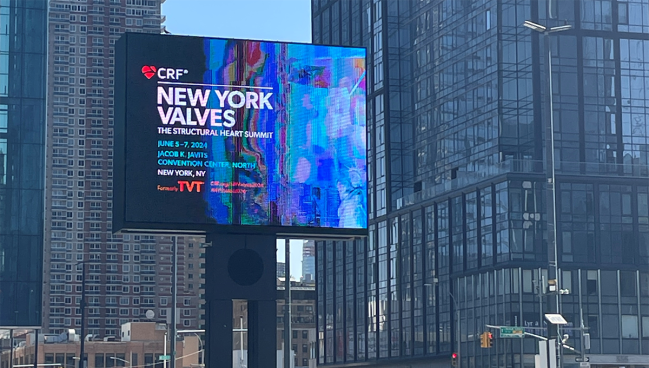National Data Point to Soaring TAVI Rates in Patients Under 65
Some are calling for a randomized trial, but whether anyone would be willing to randomize is another question entirely.

NEW YORK, NY—Yet more data, this time from a nationwide registry, show that TAVI rates are rapidly climbing in very young patients, with more than 40% of patients aged 50 to 64 years treated with the transcatheter approach instead of surgery for symptomatic severe aortic stenosis.
The new analysis from the National Inpatient Sample database, which was presented at New York Valves 2024 by Mayra Guerrero, MD (Mayo Clinic, Rochester, MN), showed that among these young patients who underwent isolated aortic valve replacement (AVR) between 2016 and 2020, 15,935 were treated with TAVI and 42,695 with surgery. TAVI utilization rates climbed steadily over time, up from 14.2% of AVRs in 2016 to 41.8% in 2020, while surgery declined from 85.8% to 58.2% during the same period.
Patients fared better in hospital with TAVI—the propensity-matched analysis revealed lower risks of in-hospital mortality, stroke, acute kidney injury, and major bleeding compared with SAVR—but Guerrero argued there is a pressing need for prospective, randomized trials with very long-term follow-up in those younger than 65 years.
While TAVI is indicated for patients across the surgical risk spectrum, the US valvular guidelines state that SAVR should be preferred in patients younger than 65 years or those with a longer life expectancy (> 20 years).
Amar Krishnaswamy, MD (Cleveland Clinic, OH), who co-moderated the session, questioned whether interventional cardiologists, surgeons, and general cardiologists believe there’s sufficient equipoise between SAVR and TAVI that they’d be willing to randomize into such a trial. For starters, there is no long-term data supporting TAVI in this young group, and there are significant concerns about valve durability and risks associated with TAVI explants.
“I've been working on this proposal for more than 4 years,” said Guerrero. “The pushback is precisely that—there’s not going to be clinical equipoise to randomize. It was just a crazy idea—until today, now that the data is public. I would say [TAVI in very young patients] is happening. It’s out of our hands. Most of them are treated already. It’s happening, and [insurers are] paying for it.”
This isn’t the first study to show TAVI on the rise in the very young. In one analysis of more than 250 US centers, the percentage of patients younger than 65 years who were treated with TAVI increased from 12.2% in 2015 to 47.5% in 2021. Earlier this year, a study of patients with aortic stenosis in California raised alarms when investigators reported that almost half of those younger than 60 years were treated with TAVI in 2021. It also showed TAVI was associated with a 2.5-fold higher risk of death versus surgery at 5 years. Similarly, in a study of patients in New England, TAVI and SAVR rates were roughly equal for those younger than 65 years.
“This is an alarm,” said Vinay Badhwar, MD (West Virginia Heart and Vascular Institute, Morgantown), about the accumulating data. As a member of the Cardiothoracic Surgical Trials Network, Badhwar said they’ve had multiple discussions about the best way to get the needed data with a well-designed trial. He added that surgical risks in young patients are extremely low and longitudinal outcomes are excellent.
“This is a completely data-free zone, and people are performing procedures that are way outside of anything the devices were designed for,” said Badhwar.
Bernard Prendergast, MD (St Thomas’ Hospital/Cleveland Clinic London, England), who took part in a debate about the role of TAVI in patients younger than 65 years, said it would be very difficult to present studies such as these in the UK without being “brought up in front of your medical director, if not a court of law.”
Tsunami of Failing Valves to Come
Randomized, controlled trials established a role for TAVI in low-risk patients, with the primary results from both PARTNER 3 and the Evolut Low-Risk Trial showing TAVI was noninferior to SAVR in this patient population. TAVI fared a little better in PARTNER 3, with investigators showing that the transcatheter approach was superior to surgery for reducing the primary endpoint of death, stroke, or rehospitalization at 1 year. The median age of patients was 74 years in PARTNER 3, with less than 8.0% younger than 65 years. In the Evolut trial, the mean age was also 74 years.
Cardiothoracic surgeon Keith B. Allen, MD (St. Luke’s Mid America Heart Institute, Kansas City, MO), said low risk has been incorrectly equated with young age, and there’ll be repercussions for that.
“There is a literal tsunami of failing transcatheter valves heading our way,” he said. “As structuralists, including myself as a surgeon, we need to get a handle on that. We're already seeing it. When you look at the STS Registry, and you look at when low-risk TAVI was approved, you're already beginning to see an increase in failed transcatheter valves that are requiring additional procedures. And that operation is currently not a good one. Mortality for TAVR explant is high, and complications are high.”
Panelist Mauricio Cohen, MD (Cleveland Clinic Florida, Miami), said that “nobody in their mind” would recommend TAVI to a 55-year-old patient, although he conceded that the data show it’s happening. Colin Barker, MD (Vanderbilt University Medical Center, Nashville, TN), who co-moderated the session, joked that the panelists must be the exception to the rule given the staggering rise of TAVI in such young patients.
“Most of us would not refer somebody for TAVR who is younger than 65 and healthy,” said Barker.
Itsik Ben-Dor, MD (Medstar Washington Hospital Center, DC), on the other hand, said that if the CT imaging shows favorable anatomy without a lot of left ventricular outflow tract calcification and simulations show that he could perform valve-in-valve TAVI in the future, he’d be willing to treat a patient in his early 60s.
Prendergast noted that patients today have multiple choices, including a Ross procedure, surgery, or TAVI for symptomatic severe aortic stenosis.
“All of these options have their pros and cons, but we do have to acknowledge that even in 2024, surgery is a very invasive undertaking from the patient's perspective, with a median sternotomy and cardiopulmonary bypass, and all that brings,” said Prendergast. “There are also some very important truths—in 2024, nobody wants a mechanical valve if they're given a choice, and secondly, nobody wants SAVR if they can somehow access TAVI. In the era of patient-directed care, these are realities that we have to deal with on a week-by-week basis.”
During the presentation, Guerrero pitched the Young TAVI trial, which she said would require approximately 1,000 patients aged 50 to less than 65 years old with favorable anatomy for both TAVI and surgery. All-cause mortality, stroke, and rehospitalization for procedure-, valve-, or heart failure-related causes at 3 years would be a suitable primary endpoint, but additional registry-based follow-up of 20 years would be needed, Guerrero added.
“We might as well do it in an organized way, collecting the data, and making sure that we can collect data long-term,” she said. “This is not a question about what happens to the index procedure, but what happens with the second procedure, the third procedure. The only way that we'll know would be to do this in an organized, prospective fashion, not only at a national level but also multinationally.”
Michael O’Riordan is the Managing Editor for TCTMD. He completed his undergraduate degrees at Queen’s University in Kingston, ON, and…
Read Full BioDisclosures
- Guerrero reports an institutional research grant from Edwards Lifesciences.
- Badhwar and Ben-Dor reports no conflicts of interest.
- Barker reports consulting fees/honoraria from Medtronic and Aleviant and grant/research support from Edwards Lifesciences.
- Cohen reports consulting fees/honoraria from Medtronic, AstraZeneca, Terumo, Abbott, and Cordis.
- Prendergast reports consulting fees/honoraria from Edwards Lifesciences, Anteris, and Microport. He serves on a trial steering committee and DSMB for Medtronic and Valvosoft, respectively.
- Allen reports consulting fees/honoraria and grant/research contracts from Edwards Lifesciences, Medtronic, and Abbott.





Comments